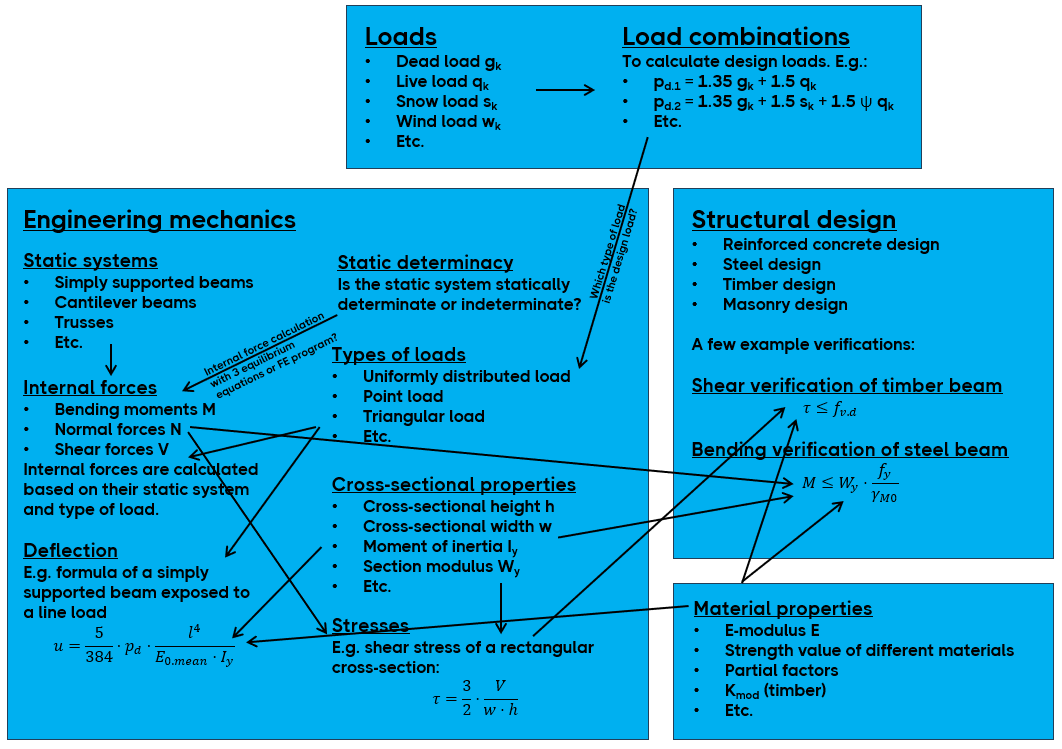Welcome to the Reinforced Concrete Series (Ep. #1)
|
Happy Wednesday, 🌞🌞 Today, we’re kicking off the biggest series yet - the reinforced concrete series. The next weeks and months will be packed with structural engineering value. For this knowledge, people pay hundreds of dollars for to learn in university classes and seminars. But it’s going to be completely free for you in this newsletter. Those of you who have been around for some time understand now how we structured the content of the last months. We have built up our knowledge of structural engineering fundamentals to be able to dive into structural design now.
These 2 series were necessary to have the necessary foundation to build a strong and stable building. In my opinion, structural engineering verifications can be split up into 3 or 4 parts:
Without knowing how to calculate loads or which static system to use, you can’t design a reinforced concrete beam correctly. Introduction To What’s ComingThere will be so much content, guys. I did a quick brainstorming session a few weeks back, writing down article topics, and the list is huge. I hope you are ready for it. Occasionally, we’ll be publishing content about other topics, as we have been doing. This could be a guest post, a personal story from our industry, an article about a cool tool or workflow I use. So here are a few topics we’ll be covering in this new series:
Once we have covered these verifications/”basics”, we’ll move on to design “real” structural elements. Design and verification of:
These were a few article topics from my list. And as we go, I’ll find new topics, which we’ll write about. Final WordsI am really excited about this new series, because structural design is the thing I enjoy the most about structural engineering. And seeing your design come to life is really rewarding. Our designs have an impact on other people’s life and our environment. If you want to catch up on engineering basics (which will definitely help you for the reinforced concrete series), I’ll recommend checking out our video tutorial on the different types of beams, we use in structural engineering. Short intro today, I’ll see you next Wednesday. Cheers, 👋👋 Laurin. ↓ Follow me on Social Media. ↓ |
Structural Basics
Personal insights and calculation guides from the world of structural engineering directly in your inbox.
Hi friends, I didn't send out a newsletter last week and today's newsletter will be a short one. The reason is that I've been quite busy the last few weeks - both at work and in my personal life. So today, I just wanted to update you on a few things. Online shop closure As you know, I closed the online shop until the end of the year. I've received many e-mails and messages why the online shop is closed and why people can't buy the books. There are 2 reasons: I sold almost too many e-books....
Happy Wednesday and welcome back, Today, we'll cover CLT floors, and I'll show you how to design and verify it according to Eurocode. What is a CLT Floor? Before designing it, we first need to know what CLT and a CLT floor is and how it works. CLT stands for cross-laminated timber. It means that timber layers (in most cases structural wood like C24) are stacked together at right angles. Like for example the first layer points in y-direction, layer 2 and 4 in x-direction, while layers 3 and 5...
Hi friends, Folk supports are used in the lateral torsional buckling analysis of timber, steel and precast concrete beams. Whether the supports are folk supports or not has a huge impact on the buckling resistance of the beams. In this newsletter, you’ll learn what folk supports are, and I show you 5 examples of supports which are and are not folk supports. What Exactly is a Fork Support? Short explanation: The term fork support means that, at support, the beam is prevented from twisting...
